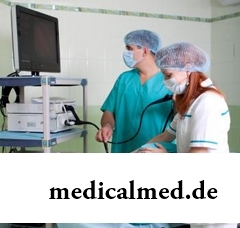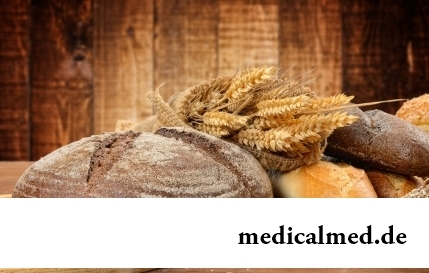





Gastroscopy
 Gastroscopy is a kind of an endoscopic research at which examine mucous upper parts of digestive tract (a gullet, a stomach, a duodenum). Other alternative versions of the name are FGDS (fibrogastroduodenoskopiya), EGDS (ezofagogastroduodenoskopiya), the fibrogastroscopy. It is about the same inspection, despite a variety of names. It is possible to make gastroscopy on doctor's orders, it is not necessary most to appoint to himself such research.
Gastroscopy is a kind of an endoscopic research at which examine mucous upper parts of digestive tract (a gullet, a stomach, a duodenum). Other alternative versions of the name are FGDS (fibrogastroduodenoskopiya), EGDS (ezofagogastroduodenoskopiya), the fibrogastroscopy. It is about the same inspection, despite a variety of names. It is possible to make gastroscopy on doctor's orders, it is not necessary most to appoint to himself such research.
Now gastroscopy of a stomach is carried out by means of a flexible fibrogastroskop in whom the fiber-optical system is placed. Thanks to mobility of distal (trailer) department of the device, it is possible to examine all sites mucous a gullet, a stomach and a duodenum. Gastroscopy without pain is reality. This procedure can carry both diagnostic, and medical character. Endoscopic digestive tract operations become more and more popular, and sometimes they allow to avoid open surgical interventions (for example, the helcomenia of a stomach can be stopped at gastroscopy by means of various methods – coagulations, clipings).
It is possible to make stomach gastroscopy in out-patient conditions, inspection is eurysynusic and becomes practically everywhere (policlinics, the private centers). Most often gastroscopy is appointed concerning complaints of the patient to nausea, pain in upper parts of a stomach, appetite change. This inspection surpasses all radiological methods in diagnosis accuracy, allows to carry out a biopsy and medical manipulations. Performance of gastroscopy to children of all age is possible.
Indications to gastroscopy
Indications to this inspection rather wide, at any suspicion of a disease of bodies of a digestive tract purpose of gastroscopy is justified.
- Pains in upper parts of a stomach, nausea, vomiting, heartburn;
- Symptoms of bleeding from upper parts of a digestive tract (vomiting with blood, a loss of consciousness, a characteristic chair - a melena);
- Signs of bad passing of food when swallowing;
- Suspicion on oncological process (anemia, weight loss, lack of appetite);
- Diseases of other bodies of a GIT at which it is necessary to know a state mucous a stomach (for example, acute pancreatitis).
Contraindications
Contraindications to performance of gastroscopy depend on in what order the research is carried out. At the emergency gastroscopy (for example, at plentiful bleeding) contraindications are practically absent, and it can be carried out even at the patient with an acute myocardial infarction.
For planned gastroscopy contraindications are:
- Heavy cardiovascular insufficiency, acute myocardial infarction;
- Acute disorder of cerebral circulation;
- The expressed respiratory insufficiency;
- The recovery period after an acute myocardial infarction or a stroke;
- Aortic aneurysm, aneurism of heart, aneurysm of carotid sine;
- Disturbances of a cordial rhythm;
- Hypertensive crisis;
- Heavy mental disturbances.
In the presence of contraindications consultation of the corresponding specialist is required to estimate probability of emergence of negative effects from a research and to estimate its expediency.
Preparation for stomach gastroscopy
Carrying out a research requires a condition that it was carried out on an empty stomach. The last meal has to be not less than in 6-8 hours prior to gastroscopy. Most often the procedure is carried out in the morning therefore it is enough of that in the morning the patient did not eat and did not drink. In the presence of removable dentures they need to be removed before carrying out a research. At a research it is important to estimate correctly mucous bodies of a GIT therefore preparation for gastroscopy of a stomach is very important for the patient. In 2-3 hours prior to a research smoking is forbidden. In a case performance of gastroscopy under anesthetic the period of starvation can be prolonged till 10-12 o'clock.
Anesthesia
Gastroscopy without pain – a wish of all patients. In spite of the fact that pain during the research is practically absent, most of patients wait for them from manipulation. Usually gastroscopy of a stomach is carried out after irrigation of a throat by solution of local anesthetic (lidocaine), it becomes to lower an emetic reflex at the patient. Sometimes at the request of the patient (or according to indications) carrying out a research in the conditions of the general anesthesia is possible (intravenous), however gastroscopy under anesthetic can be executed on an outpatient basis not at all patients.
Technology of carrying out gastroscopy
For carrying out manipulation the patient keeps within on a table in situation on the left side, with a little bent legs, the back has to be straightened. Gastroscopy under anesthetic can be carried out also in situation on spin. After introduction of the gastroscope to an oral cavity of the patient ask to make the deglutitory movement which facilitates advance of the device in a gullet. To suppress an emetic reflex the patient has to observe quet deep breathing. Via the gastroscope air moves to straighten folds mucous a stomach and fully to examine all mucous membrane. Fear to choke during stomach gastroscopy absolutely unreasonably as interferes nothing with breath of the patient.
 The doctor will attentively examine the internal surface of a gullet, stomach and duodenum, and in case of need will take a biopsy (a fabric piece). Medical manipulations are carried out by introduction to the channel of the endoscope of additional tools. Thus, it is possible to remove polyps (and also submucosal new growths) a gullet, a stomach or a duodenum, to stop bleeding from ulcers (acute and chronic), to impose ligatures on varicose expanded veins of a gullet, to take foreign bodys from a gastric cavity.
The doctor will attentively examine the internal surface of a gullet, stomach and duodenum, and in case of need will take a biopsy (a fabric piece). Medical manipulations are carried out by introduction to the channel of the endoscope of additional tools. Thus, it is possible to remove polyps (and also submucosal new growths) a gullet, a stomach or a duodenum, to stop bleeding from ulcers (acute and chronic), to impose ligatures on varicose expanded veins of a gullet, to take foreign bodys from a gastric cavity.
Gastroscopy to children
Performance of gastroscopy to children has a number of features. A mucous membrane at them thin, vulnerable, rich with vessels, the muscular layer of walls of bodies is developed poorly. Therefore special endoscopes of smaller diameter (only 6-9 mm) are used to children. At a younger age group (up to 6 years) gastroscopy under anesthetic is carried out. At children, 6 years are more senior, the general anesthesia is not required. The indication to an anesthesia is serious condition of the child or considerable duration of a research on time. Preparation for stomach gastroscopy at children has no distinctions, in comparison with adults.
If your liver ceased to work, death would come within a day.

The body of the person almost for 60% consists of water. It is so important for normal functioning of an organism that loss of all is ponut...
Section: Articles about health
The summer of this year in Russia was very ambiguous. Regions suffered from a merciless heat, from pouring rains, the hail from time to time dropped out, then there was again a heat which alternated with rainfall again. Many people suffer from such sharp changes of weather...
Section: Articles about health
The saying "the rich do not know how the other half lives" is known to all. In a broad sense it is that we can not always understand the person whose features of a state are unknown to us. If with physiological characters of diseases the situation is more or less clearly (having noticed them, we realize that to the person nezdorovitsya), then with symptoms of the illnesses affecting the mental sphere everything is much more difficult. Not absolutely usual behavior is quite often perceived surrounding as a ridiculous eccentricity, or that much ху...
Section: Articles about health
Extracorporal fertilization – one of the most modern methods of controlling with infertility. So far it already helped znach...
Section: Articles about health
Antibiotics - - it is possible to call the chemical compounds suppressing growth of bacteria the break in the field of medicine which allowed to save mankind from many diseases incurable earlier: tuberculosis, plague, syphilis and many others. A contribution of drugs to rescue of people from...
Section: Articles about health
Cystitis, or inflammation of a mucous membrane of a bladder, this very widespread disease which, owing to some features of a structure of bodies of urinogenital system, women have approximately four times more often than men. Women aged from 20 up to 45 years enter into the main risk group. Cystitis is an illness of a bacterial origin. It can have an acute or chronic current. The second option is dangerous not only a frequent recurrence, серьезн...
Section: Articles about health
It is pleasant to state a possibility of improvement of quality of life of people with problems of functioning of secretory system. By efforts that...
Section: Articles about health
Cold, puffiness of a nose, itch, the watering eyes - characteristic symptoms of the allergic rhinitis resulting from hit of allergens (pollen, house dust, hair of animals, etc.) on a mucous membrane of a nose. Unpleasant feelings often deliver беспоко...
Section: Articles about health
Dietary supplements (dietary supplements) for the last decades were so thoroughly included into our life that, apparently, it is already impossible to find the person who at least once did not try them. At the same time, most of our compatriots have a vague idea of what dietary supplements as they affect a human body consist of and what differ from the real medicines in. Let's try to understand these questions, and at the same time and to understand, such additives are how necessary for us....
Section: Articles about health
For most of the working people the problem of having a snack is particularly acute enough. Sooner or later there is a question: what is possible quickly for a sja...
Section: Articles about health
Shops of household appliances offer us the huge choice of various devices for the house. Whether there are among this abundance devices which not only facilitate house work, but also help to keep health of the person? Of course, and we will tell about them today....
Section: Articles about health
To look healthy and means well-groomed not only to be pleasant to people around, but also to feel strong, sure and taken place. Specialists in the field of cosmetology quite often note that not all women are able to look after face skin. Many women incorrectly apply cosmetics, ineptly use various procedures, without having exact information on their real influence and dividing numerous delusions about it. All this not the best...
Section: Articles about health
The climax, or menopause is the normal process of the termination of genital function of the woman which is followed serious hormonal...
Section: Articles about health
The winter swimming in open reservoirs called in our country by "winter swimming" – officially recognized sport and one of the most extreme ways of a hardening of an organism. This occupation has an old story and adherents in many countries. Are annually carried out...
Section: Articles about health
Beauty shop – the place which is associated only with positive emotions: joy, pleasure, relaxation. However visit of salon where work with biological material of clients, not always harmlessly is conducted. Today more than 100 pathogenic microorganisms who can catch in beauty shop including deadly to health are known....
Section: Articles about health
For the person who daily since morning gathers for work it is very important to wake up vigorous and ready by day of work. On most...
Section: Articles about health
The fatigue, sleep debt, disturbances of food, bad mood, vagaries of the weather – all these circumstances badly affect our appearance. Especially the person suffers: skin becomes flabby, loses healthy color, becomes covered by wrinkles, zones of hypostases and t appear...
Section: Articles about health
Coffee – favourite drink of many. For the last decades it more than once already declared very harmful, extremely useful and even necessary for normal life activity. In spite of the fact that this product became for us usual for a long time, there are many myths about properties of coffee and its impact on a human body. Readers can get acquainted with the most widespread of similar delusions today....
Section: Articles about health
Stability of a hormonal background is one of the most important conditions of preservation of health of the woman. At the same time endocrine system –...
Section: Articles about health
Bathing in broths of medical flowers and plants (phytobathtub) was eurysynusic since Cleopatra who is a good judge in all that concerns beauty and health. And today phytobathtubs is the simple and available means allowing not only to remove nervous N...
Section: Articles about health
An eye of the person daily experiences considerable strain. The problem of preservation of sight is for many years directly connected with a question of supply of tissues of eye enough oxygen and nutrients. This task is carried out by small vessels – capillaries. For normal functioning of the visual device extremely important that they kept the integrity, but it works well not always. Microtraumas of eye vessels during which there are small hemorrhages it is extraordinary расп...
Section: Articles about health
On health of the person physicians know about salutary action of animals long ago. About 7 thousand years ago great Hippocrates рекоменд...
Section: Articles about health
Scientists have no unambiguous opinion on a proximate cause of emergence of a carcinoma cutaneum today. Only the factors promoting development of this illness are precisely established. Treat them: long impact on skin of ultraviolet rays, radioactive...
Section: Articles about health
Musicotherapy – a treatment method which caused and causes a set of a controversy concerning its efficiency. However the facts are relentless: during the numerous researches curative impact of music on an organism was scientifically confirmed. Since then in a number of the countries the technique is included complex therapy of diseases of cardiovascular and respiratory system, dorsodynias and a backbone, psychosomatic disturbances and many other illnesses. The musicotherapy in a pedi is especially widely applied...
Section: Articles about health
There is an opinion that at low temperatures safety of products is ensured longer and better thanks to what the refrigerator considers...
Section: Articles about health
Aspirin (acetylsalicylic acid) – one of those drugs which are known literally to all. It is available in each home first-aid kit, and many accept it at the first signs of an indisposition, often without having a fair idea of properties and a therapeutic eff...
Section: Articles about health
The modern person not always manages to find housing in the environmentally friendly region and such work which would not do harm to health. With food stuffs at first sight the situation is much better: shops are overflowed with goods which are positioned by producers as very useful and absolutely safe. Many Russians are absolutely sure that the choice of products with marking "bio", "эко" or "organik" guarantees them and members of their families an optimal variant of food. To a sozhala...
Section: Articles about health
